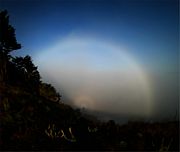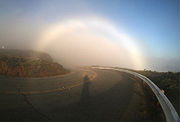
Fog bow
Encyclopedia



Rainbow
A rainbow is an optical and meteorological phenomenon that causes a spectrum of light to appear in the sky when the Sun shines on to droplets of moisture in the Earth's atmosphere. It takes the form of a multicoloured arc...
, however, as its name suggests, it appears as a bow in fog
Fog
Fog is a collection of water droplets or ice crystals suspended in the air at or near the Earth's surface. While fog is a type of stratus cloud, the term "fog" is typically distinguished from the more generic term "cloud" in that fog is low-lying, and the moisture in the fog is often generated...
rather than rain
Rain
Rain is liquid precipitation, as opposed to non-liquid kinds of precipitation such as snow, hail and sleet. Rain requires the presence of a thick layer of the atmosphere to have temperatures above the melting point of water near and above the Earth's surface...
. Because of the very small size of water droplets that cause fog
Fog
Fog is a collection of water droplets or ice crystals suspended in the air at or near the Earth's surface. While fog is a type of stratus cloud, the term "fog" is typically distinguished from the more generic term "cloud" in that fog is low-lying, and the moisture in the fog is often generated...
—smaller than 0.05 millimetre (0.00196850393700787 in)—the fog bow has only very weak colors, with a red outer edge and bluish inner.
In many cases when the droplets are very small, fog bows appear white, and are therefore sometimes called white rainbows. This lack of color is a distinguishing feature from a glory
Glory (optical phenomenon)
A glory is an optical phenomenon that resembles an iconic saint's halo about the shadow of the observer's head. The effect is produced by light backscattered towards its source by a cloud of uniformly sized water droplets...
, which has multiple pale colored rings caused by diffraction. When the droplets forming it are almost all of the same size the fog bow can have multiple inner rings, or supernumeraries, that are more strongly colored than the main bow. According to NASA
NASA
The National Aeronautics and Space Administration is the agency of the United States government that is responsible for the nation's civilian space program and for aeronautics and aerospace research...
:
The fogbow's lack of colors is caused by the smaller water drops ... so small that the wavelengthWavelengthIn physics, the wavelength of a sinusoidal wave is the spatial period of the wave—the distance over which the wave's shape repeats.It is usually determined by considering the distance between consecutive corresponding points of the same phase, such as crests, troughs, or zero crossings, and is a...
of light becomes important. Diffraction smears out colors that would be created by larger rainbowRainbowA rainbow is an optical and meteorological phenomenon that causes a spectrum of light to appear in the sky when the Sun shines on to droplets of moisture in the Earth's atmosphere. It takes the form of a multicoloured arc...
water drops ...
A fog bow seen in clouds, typically from an aircraft looking downwards, is called a cloud bow. Mariners sometimes call fog bows sea-dogs.
Direction
A fog bow is seen in the same direction as a rainbow, thus the sun would be behind the head of the observer and the direction of view would be into a bank of fog (which may not be noticeable in directions away from the bow itself). Its outer radius is slightly less than that of a rainbow.When a fog bow appears at night it is called a lunar fog bow.
See also
- RainbowRainbowA rainbow is an optical and meteorological phenomenon that causes a spectrum of light to appear in the sky when the Sun shines on to droplets of moisture in the Earth's atmosphere. It takes the form of a multicoloured arc...
- MoonbowMoonbowA moonbow is a rainbow produced by light reflected off the surface of the moon rather than from direct sunlight. Moonbows are relatively faint, due to the smaller amount of light reflected from the surface of the moon...
- Circumhorizontal arcCircumhorizontal arcA circumhorizontal arc is an optical phenomenon - an ice-halo formed by plate-shaped ice crystals in high level cirrus clouds.The current accepted names are circumhorizon arc or lower symmetric 46° plate arc The complete halo is a huge, multi-coloured band running parallel to the horizon with its...
- Circumzenithal arcCircumzenithal arcThe circumzenithal arc or circumzenith arc , also called the Bravais' arc, is an optical phenomenon similar in appearance to a rainbow; but it arises from refraction of sunlight through horizontally-oriented ice crystals, generally in cirrus clouds, rather than from raindrops...
- HaloHalo (optical phenomenon)A halo from Greek ἅλως; also known as a nimbus, icebow or gloriole) is an optical phenomenon produced by ice crystals creating colored or white arcs and spots in the sky. Many are near the sun or moon but others are elsewhere and even in the opposite part of the sky...
- Sun dogSun dogA sun dog or sundog, scientific name parhelion ; , also called a mock sun or a phantom sun, is an atmospheric phenomenon that creates bright spots of light in the sky, often on a luminous ring or halo on either side of the sun.Sundogs may appear as a colored patch of light to the left or right of...
External links
- Photos and explanation of fogbows at Atmospheric Optics.
- Fogbow image gallery at AKM website.
- Fogbows at Glows, Bows and Haloes site.

